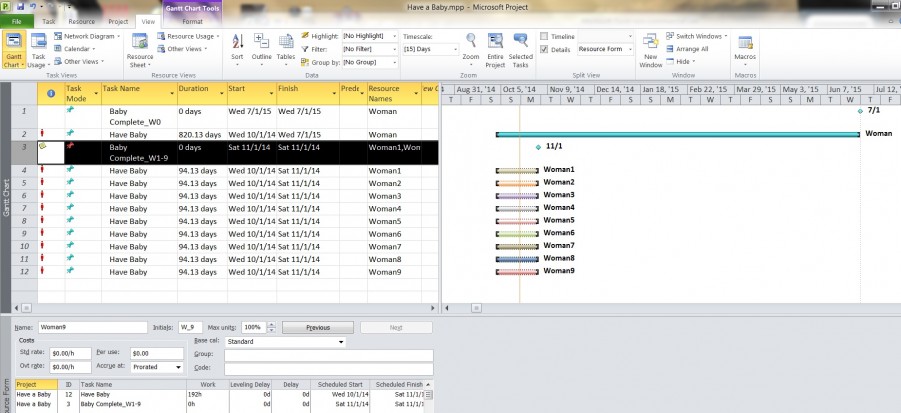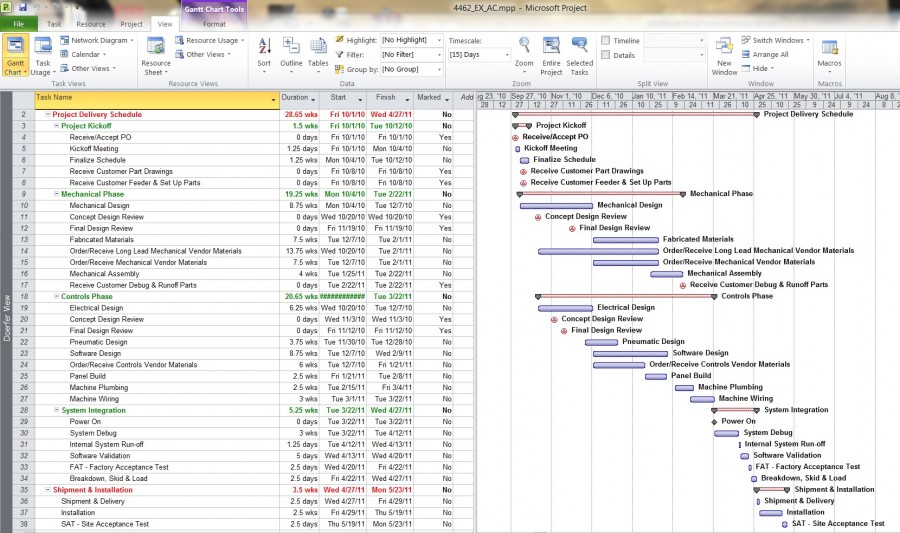How Long Does It Take?

One of the most difficult tasks in project management and quoting machinery is determining how long the project will take to complete and what resources will be required. Estimates directly impact the bottom line as well as determining whether you get the job at all.
If you underestimate the time it will take to complete the job you will probably lose money on the project. The customer will also not be happy when you are late. If you pad the schedule it reduces the chances of getting the job in the first place.
As you can see from the Gantt chart above, adding resources may help shorten the schedule and keep the customer happy, hopefully without impacting the resource cost too much. You may have also heard the saying “Nine women can’t make a baby in a month”. As you can see from the above chart, this is clearly not true.

The Gantt chart above is a better example of a typical machinery project. As you can see, while there are tasks and phases that can run concurrently, many tasks also depend on completion of a previous task. Many of the milestones are non-negotiable: you can’t start building something until you have parts to build it with. You can’t start wiring a machine until there is a machine to wire. You can’t start debug until the machine has been powered on and is substantially completed.
There are other tasks that are somewhat flexible. Sometimes more resources can be added to shorten the time it takes to complete a task. Maybe the vendor materials can be expedited or substituted. People can work longer shifts. It is important that the person making these estimations and adjustments understand the limitations of their resources however. Just because your assembly guy happens to know a little bit about PLC programming and has some free time doesn’t mean you can shorten the time it takes for software development. Then again, maybe it does… it depends on the type of project and the ability of the resources.
Probably the most critical part of making time estimations is a history of how long it has taken to complete similar tasks in the past. Once you have done lots of projects and kept good records you will have a good idea of how long different tasks will take given your existing resources. Often it is then a matter of scaling hours estimates based on different parameters such as I/O and actuator counts, weight or lengths of steel or extrusion, numbers of fasteners, etc. This will often get you in the ballpark as far as a total number of hours by discipline.
Then there is the matter of making sure your personnel have available the number of hours required for the job. Obvious problems like double booking someone can be handled in the scheduling software (I use Microsoft Project). What is not so obvious is the time it takes for people to mentally switch from one project to another. It is fine to say that a controls or software engineer can work on three different projects at once, but in my experience this is often less than efficient. On the other hand, if a design engineer is assigned to a project for its full duration, they will usually find a way to fill all of the assigned hours whether working on the project or not. This is also not very efficient.
The bottom line on estimations of time and resources on projects is that it takes a lot of experience to accurately project how long a project will take to complete. This starts with the applications department: they strike the first balance between ensuring that the project can be completed on time using existing or contract resources and not throwing so many hours at a job that the price or schedule is unacceptable to the customer. Most complex quotes are reviewed by a committee of technical and management people to help strike this balance.
The next part of the equation is management of the project to ensure that timelines are held to and resources are used efficiently. While this is often accomplished by Project Managers, resources may be used across multiple projects with different managers. This often requires coordination between different departments.
I have mentioned before that there are a variety of tools that can be used to help in the quoting and project management disciplines. Microsoft Project is an excellent method of allocating hours and resources, while Excel can be used to create applications spreadsheets and resource forecasts. Part of a software project that I have been working on also addresses resource usage and allocation.
A project I am involved in that I have described previously is part of what inspires today’s post. Project scheduling, mechanical and electrical design and software are all currently on my plate unless more resources are found. Ideally these resources would be local to the plant, but the job needs to get done regardless. I have considered hiring someone in that area, but that is a big step that I am not sure I want to take -again-. Please contact me if you have interest in becoming involved, especially if you are in the Florida area and/or have Spanish skills.

It’s easy to estimate the time line. It’s not accurate or cost effective to use Project in the estimation portion of the project, after all you’re not getting paid to make the estimate and therefore you’re not getting paid to estimate the time.
So, what do you do??
What I do is look at the total hours in the project and divide by the number of hours that the available people can put in (and by that, I’m talking about the slowest, most lazy person you have on staff)..you can NOT quote the average or the fastest person-you’ll lose money every time you do.
If you have, let’s say, 4 people in mechanical design/engineering, 2 in controls, 10 in the shop to fabricate and assembly and you’re quoting a 1000 hour project. Unless all of your people will be free to work on this project the instance it hits your door, you’re going to have some delay before you can start it. Additionally, your people will be working on other projects and will not be available the instant when you need them.
Your shop work load will determine when the project can go to the shop…be worked in along with finishing other projects.
Hi Randall Wink, It seems you are planning a conservative and safe schedule. do you meet such situation there are competitors which have more aggressive schedule than you, then how to make sure you get the order from the customer? and usually, what’s your contingency plan for crashing?
First of all, you shouldn’t go after every project that comes in the door-you can’t make money on all of them because they are too risky, strain your resources or don’t have enough money in them to make a profit. You should be picking and choosing which projects you’re doing. Conservative-yes very. I don’t want to ship money with the project.
BUT we’re talking in the quoting stage. Quotes cost money-you have a lot of time in it trying to get the concept right so you can get the money right so your company can make money. The more time you spend putting together a quote, the less overall profit you’ll make. You need to find ways to short circuit the process and still get the job done. Putting together a detailed project schedule before you get the project is just plain wasteful of time and resources. If you lose a project because your delivery is a little longer than someone else’s, then you didn’t have a good enough rapport with your customer-poor salesmanship.
I’ve found that if you’re screening the projects correctly, you’ll get between 10%-20% of the projects you quote. If you keep track of who gets the other 80%, you find that most times they will lose money on the project and or be late with delivery.
We are always challenged to produce an estimate and schedule that is both realistic and competitive. Our approach is to assume everything will go as planned, and then project manage using proper change control when it doesn’t. Of course we all realize this is more art than science.
In a deal that has a lot of Trading Partners, we have to assume timely correspondence with that community. Our “out” there is that we put in the SOW that our customer owns that, so we have a change control capability to extend the project if the TPs are not responsive. The SFTP and AS2 protocols do not take a lot of time to configure on our system, our estimates for those setups are really conservative.
On the subject of “8 weeks”, generally this is the minimum project length, so all small projects get the same allocation.